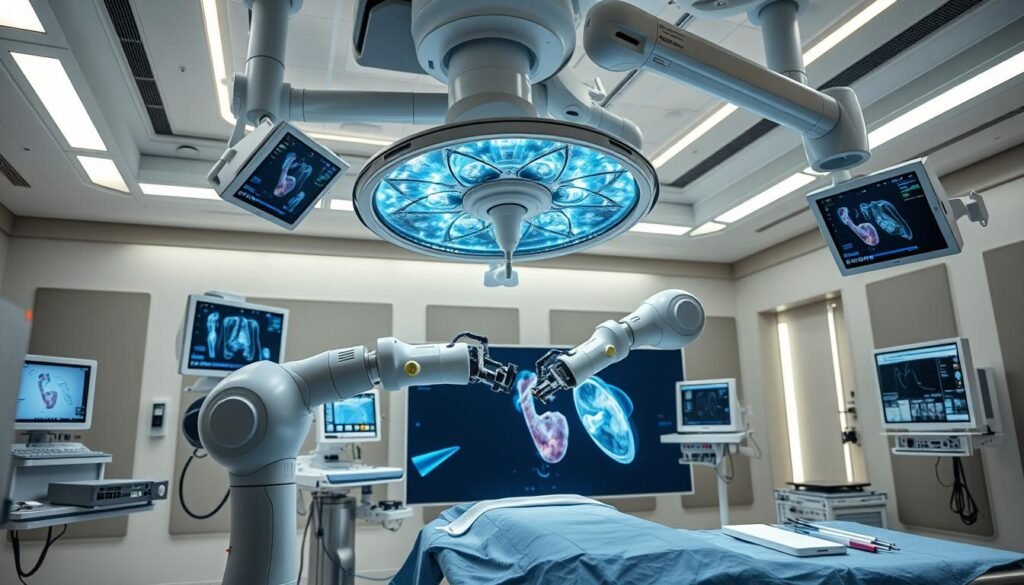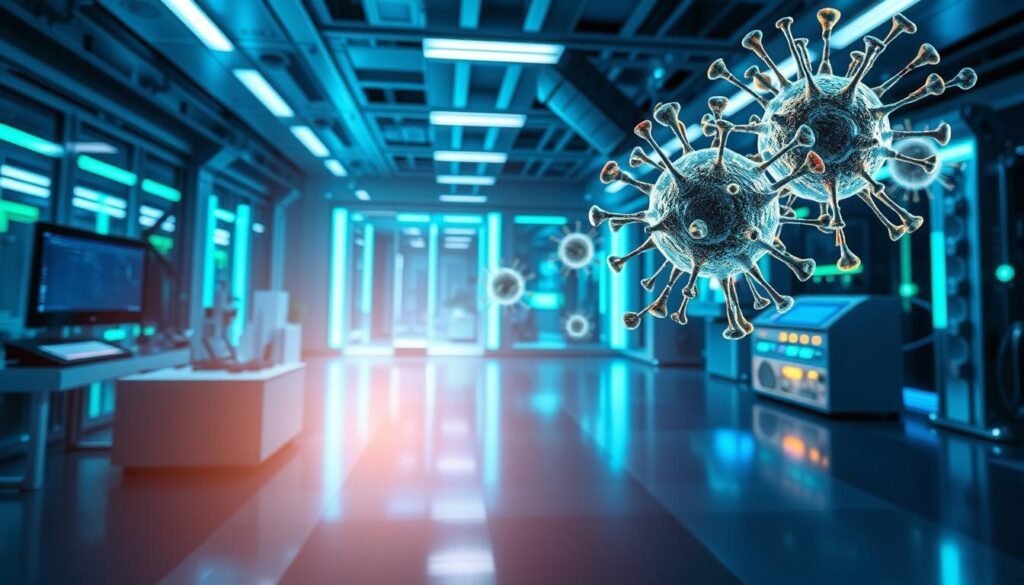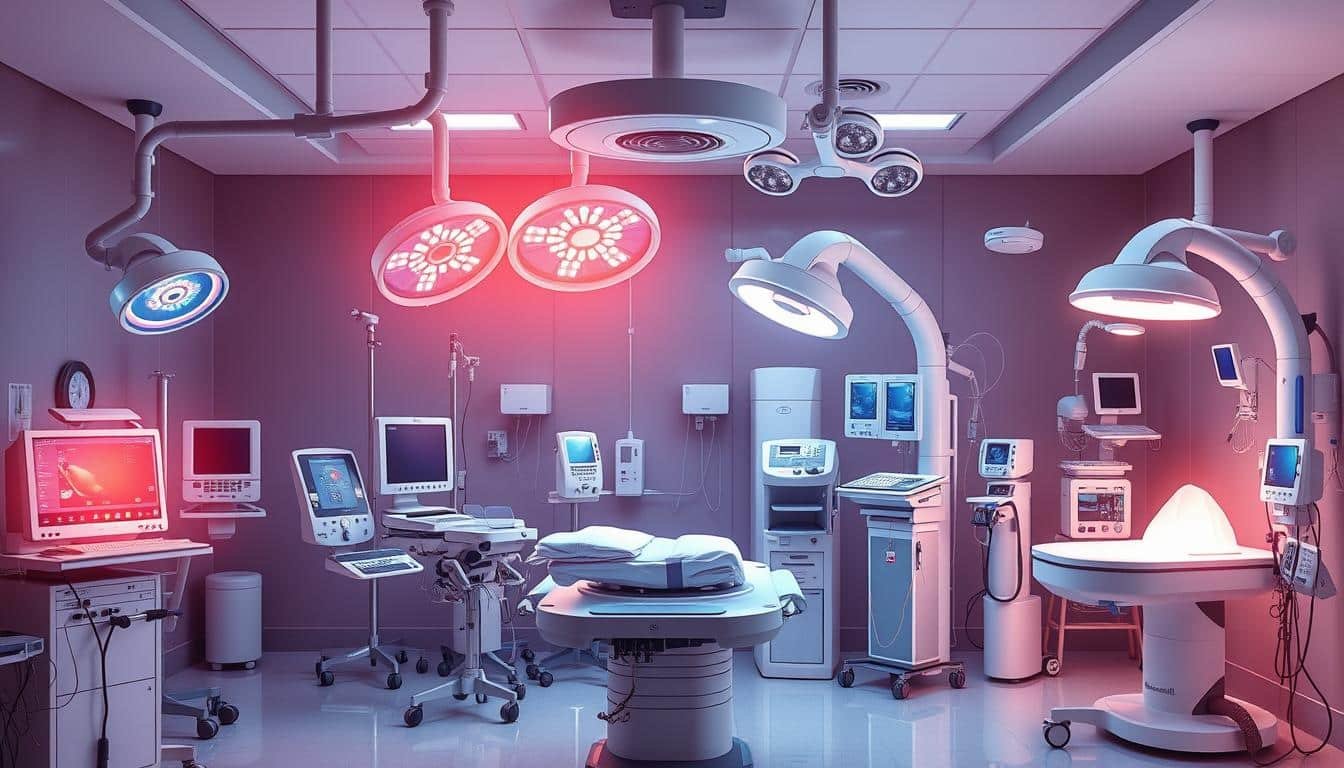The fight against cancer needs many approaches. There are various treatments available. From surgery to immunotherapy, the field has grown, offering hope and better results for those fighting cancer.
Choosing a treatment depends on the cancer type, stage, and the patient’s health. The main goal is to get rid of cancer cells without harming healthy tissue. Treatments can include surgery, chemotherapy, and immunotherapy.
Adjuvant therapies like chemotherapy help after the main treatment. Neoadjuvant therapy is used before to shrink tumors. Palliative care improves life quality by managing symptoms and offering emotional support.
Every treatment has possible side effects. Healthcare teams help manage these to ensure the best results. Patients should be involved in their care, seek opinions, and use support resources to understand treatment.
Key Takeaways
- Cancer treatment options range from traditional methods like surgery to innovative approaches such as immunotherapy.
- The choice of treatment depends on the type and stage of cancer, as well as the patient’s overall health.
- Primary treatment aims to remove or kill cancer cells, while adjuvant therapy targets remaining cells after initial treatment.
- Palliative care focuses on improving quality of life for patients and families.
- Treatment side effects vary and are managed by healthcare teams.
Also Read : The Art Of Home Cooking: Elevating Everyday Dishes
Understanding Cancer and Its Impact on Health
Cancer is a complex disease that affects millions worldwide. It’s a group of diseases where abnormal cells grow and spread. These cells can form tumors and spread to other parts of the body, causing damage and often leading to death.
Also Read : Urban Wildlife Conservation: Protecting Nature In Growing Cities
Types of Cancer and Their Characteristics
There are over 100 types of cancer, each unique. Cancers can be solid tumors or affect the blood and lymphatic system. Common types include breast cancer, lung cancer, skin cancer, prostate cancer, cervical cancer, and liver cancer.
How Cancer Develops and Spreads
Cancer starts with genetic changes that let cells grow uncontrollably. These changes can come from genetics or environmental factors like tobacco smoke or UV radiation. As tumors grow, they can spread to other parts of the body through the bloodstream or lymphatic system.
Also Read : The Role Of Animal Nutrition In Enhancing Immune System Function
Risk Factors and Prevention
Many factors can increase cancer risk, including age, genetics, and lifestyle. Cancer screening and early detection are key. By living a healthy lifestyle and avoiding carcinogens, you can lower your risk.
Understanding cancer types, causes, and risk factors is crucial. Ongoing research and advancements in oncology offer hope and better outcomes for those fighting cancer.
Also Read : Simple Wellness Habits For A Balanced And Healthy Life
| Cancer Type | Characteristics | Risk Factors |
|---|---|---|
| Breast Cancer | Uncontrolled growth of cells in the breast tissue, can spread to other organs | Family history, hormonal factors, lifestyle factors (obesity, alcohol consumption) |
| Lung Cancer | Uncontrolled growth of cells in the lungs, can spread to other organs | Smoking, exposure to secondhand smoke, air pollution, radon gas |
| Skin Cancer | Uncontrolled growth of cells in the skin, can be categorized into different types (melanoma, basal cell, squamous cell) | Excessive UV exposure, fair skin, family history, weakened immune system |
| Prostate Cancer | Uncontrolled growth of cells in the prostate gland, can spread to other organs | Age, family history, race (higher risk in African American men) |
| Cervical Cancer | Uncontrolled growth of cells in the cervix, can spread to other organs | Human papillomavirus (HPV) infection, smoking, weakened immune system |
| Liver Cancer | Uncontrolled growth of cells in the liver, can be primary or metastatic | Chronic hepatitis B or C infection, cirrhosis, heavy alcohol use, obesity, diabetes |
“Cancer is a group of diseases characterized by the uncontrolled growth and spread of abnormal cells in the body. Understanding the various types of cancer, their underlying causes, and the factors that contribute to their development is essential for developing effective prevention and treatment strategies.”
Also Read : The Ultimate Guide To Designing A Balanced Lifestyle Routine
Primary Treatment Options for Cancer

Cancer is a complex disease needing a variety of treatments. Patients have many options, each suited to their cancer type and stage. These include surgery, chemotherapy, radiation therapy, hormone therapy, targeted therapy, and stem cell transplants.
Surgery is often the first choice for cancer that hasn’t spread. It aims to remove the tumor and affected tissues for a full recovery. Chemotherapy uses drugs to kill cancer cells all over the body. It’s great for cancers that have spread or come back.
Radiation therapy uses beams to kill cancer cells in certain areas. It can be used alone or with other treatments. Hormone therapy is key for cancers like breast and prostate, as it blocks hormones that feed cancer growth.
Targeted therapy attacks specific molecules in cancer cells, slowing their growth. It’s often used with other treatments. For some blood cancers, stem cell transplants replace damaged cells with healthy ones.
Choosing the right treatment depends on the cancer type, stage, and the patient’s health. Talking to a cancer specialist is vital for a treatment plan that works best for each patient.
“The key to successful cancer treatment is a personalized, comprehensive approach that leverages the most effective therapies for each patient’s unique needs.”
Advanced Surgical Techniques in Cancer Treatment

In oncology, surgery has made big strides, giving patients more ways to fight cancer. Now, we have options like minimally invasive and robot-assisted surgeries. These advances help tailor treatments for different cancers.
Minimally Invasive Procedures
Minimally invasive surgeries have changed cancer treatment. They cause less pain, lead to quicker recovery, and fewer side effects than old methods. These methods use small cuts and special tools to remove tumors precisely.
They work for both checking and treating cancer. This makes recovery easier and faster for patients.
Robot-Assisted Surgery
Robot-assisted surgery has brought new precision to cancer treatment. It lets doctors work with great detail and control. This is especially true for cancers in the prostate, kidney, bladder, and gynecological areas.
It combines the benefits of small cuts with the precision of robots. This leads to better results for patients.
Post-Surgical Care and Recovery
After surgery, patients need careful care to heal well. Doctors watch over them, manage pain, and prevent problems. They also help with physical therapy and nutrition to boost recovery.
The American College of Surgeons sets standards for safe and effective cancer surgery. This ensures patients get the best care possible.
| Surgical Technique | Cancer Types Treated | Key Benefits |
|---|---|---|
| Laparoscopic Surgery | Colon, Rectum, Liver, Prostate, Uterus, Kidney | Reduced blood loss, less pain, shorter hospital stays, faster healing |
| Robotic-Assisted Surgery | Prostate, Kidney, Bladder, Gynecological Cancers | Enhanced precision, control, and visualization for surgeons |
| Cryosurgery | Skin, Cervix, Penis, Liver, Prostate | Treatment of pre-cancerous conditions and some cancer types |
| Laser Surgery | Cervix, Penis, Vagina, Vulva, Lung, Skin | Precision treatment of localized cancers |
“The integration of robotic technology in cancer surgery has revolutionized the field, enhancing precision, control, and visualization for surgeons.”
Chemotherapy and Radiation: Modern Approaches

Cancer treatment has made big strides with chemotherapy and radiation. These methods are getting better to help patients more. They aim to fight cancer hard but also care for the patient’s health.
Chemotherapy targets fast-growing cells, like cancer, to stop them from growing. New chemotherapy drugs are being made to be more precise and less harsh. Using chemotherapy and radiation oncology together is also showing great results. This mix of treatments works well together.
In radiation oncology, new tech is making radiation more accurate. Targeted radiation methods like IMRT and IGRT are being used more. They help protect healthy tissue while hitting the tumor hard.
Managing side effects is key in cancer treatment today. Doctors use special care to help patients, like medicines for nausea and pain relief. This makes life better for those getting treatment.
Looking ahead, new ways to mix treatments are exciting. This could lead to even better care for cancer patients. As research goes on, patients will have more tailored and effective treatments.
“The ultimate goal in cancer treatment is to maximize the therapeutic benefit while minimizing the collateral damage. The advancements in chemotherapy and radiation therapy are crucial steps towards that aim.”
Immunotherapy: Revolutionizing Cancer Treatment

Cancer treatment has seen a big change with immunotherapy. This new method uses the body’s immune system to fight cancer. It’s a new way compared to surgery, chemotherapy, and radiation therapy.
How Immunotherapy Works
Immunotherapy boosts the immune system’s fight against cancer. It helps immune cells find and attack cancer cells. Or, it makes the immune system stronger against cancer.
Types of Immunotherapy Treatments
- Immune checkpoint inhibitors block proteins on cancer cells and immune cells. This lets the immune system attack cancer.
- CAR T-cell therapy changes a patient’s T cells to target cancer cells. It’s a personalized treatment.
- Cancer vaccines help the immune system fight cancer cells. They work like vaccines for infectious diseases.
Success Rates and Patient Outcomes
How well immunotherapy works depends on the cancer type and patient. Studies like the AMBASSADOR trial show good results for treating cancers like bladder cancer. But, not all patients get better from these treatments.
Researchers are working to find biomarkers to predict who will respond well. This could make treatments better for more people.
“Immunotherapy has the potential to revolutionize cancer treatment by harnessing the body’s own immune system to fight the disease.”
More research and trials mean immunotherapy will be key in cancer care soon. It gives patients new hope and better chances for recovery.
Also Read : What Are The Common Fever Symptoms?
Personalized Treatment Through Biomarker Testing
Biomarker testing is key in precision medicine. It helps doctors give personalized cancer care. By looking at genes and proteins, biomarker tests can predict how well treatments will work. They also track how the disease is progressing and find the best treatments for each person.
Personalized treatments based on biomarkers make cancer therapies more effective. They also reduce side effects. Biomarkers show what genes are active in a patient’s cancer. This helps doctors choose the best treatments, like targeted therapies and immunotherapies.
Biomarker testing is now a big part of cancer care. It’s used for many types of cancer, like lung, breast, and colon cancer. Doctors and patients see the value in this approach. It uses genetic and molecular data to make treatment plans better and increase the chances of success.





